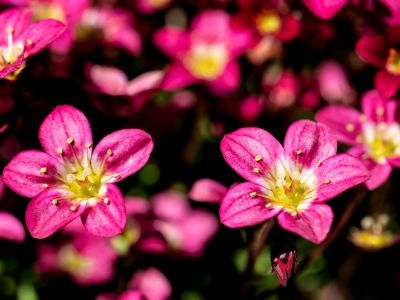Rockfoil Saxifraga Information
A commonplace form of Saxifraga is mossy rockfoil. There are many types of rockfoil, but mossy rockfoil is readily available in nurseries and garden centers. The mossy varieties are in the section of Saxifraga called hypnoides. The plant is an excellent groundcover, forming a thick, tenacious carpet over rocks and under trees. Rockfoil produces its thickest and most lush foliage in spring. The bright green, crinkly leaves pack tightly together and carpet rocks, pavers, and lightly shaded nooks. In spring, tiny, cupped flowers appear on slender stalks held above the body of the plant. The wiry stalks are tinged pink to purple and support blooms of salmon, pink, purple, white, and other hues. The rockfoil flowers last into the early part of summer. Once the flowers die back, the plant is exposed to drying air and sun without their shading protection. This often causes the plant to die in the center. Fill in the center with a light dusting of sandy grit to help the plant hold moisture and prevent core mortality. This is important rockfoil Saxifraga information to preserve the beauty of your plant. The perennial plant needs moist shade and is hardy in USDA plant hardiness zones 5 to 7 in temperate regions. Growing rockfoil requires cool sites which mimic its alpine native ranges.
How to Grow Rockfoil Plants
Mossy rockfoil has no special needs, provided you give it a location with some shelter from wind and hot sun. The plants require moist soil, especially in spring when they are growing the most. You can plant this Saxifraga from seed but for faster plants, divide a mature clump. Seeds require cold stratification for germination and can take two to three years to bloom. Growing rockfoil from divisions helps prevent the center die out and gives you more of these alpine plants for your garden. This species needs a moist, rich loam for best performance. Mix in a little compost with existing soil at planting time.
Saxifraga Plant Care
Mulch around the plants to conserve moisture and help prevent weeds from growing up into the center of the plant as it spreads. Water twice per week in summer. In colder zones, mulch over the plant lightly to protect the roots from freezes, but pull away the mulch in early spring. This allows the new growth to burst out without having to push through the layer of mulch. Mossy rockfoil needs no pruning and has no staking or manual cultivation needs. As with any plant, watch for pests and disease with Saxifraga care and maintenance. It is prey to several species of insect and prone to rots and rust. Combat these by avoiding overhead watering when the plant can’t dry out quickly and with a fungicide or baking soda spray.
